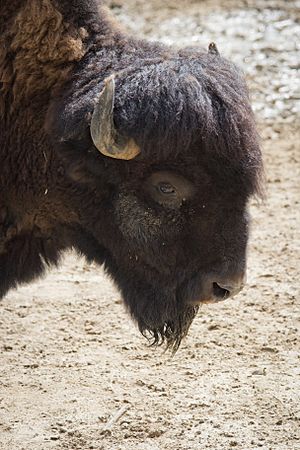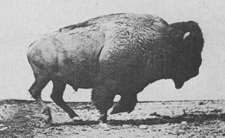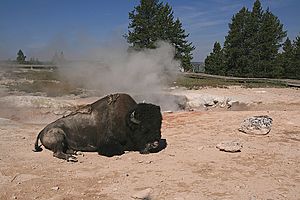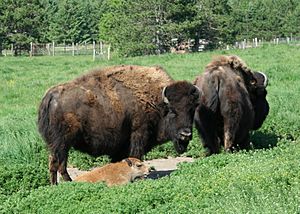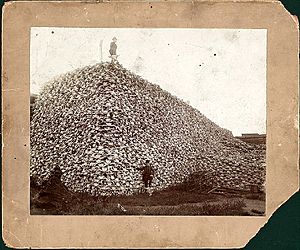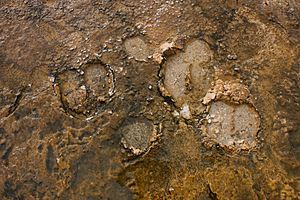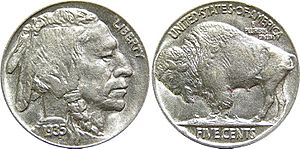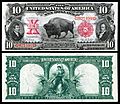American Bison facts for kids
Quick facts for kids American bison |
|
|---|---|
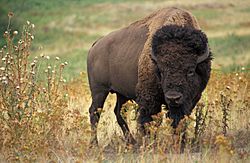 |
|
| American bison | |
| Conservation status | |
| Scientific classification | |
| Kingdom: | |
| Class: | |
| Order: | |
| Family: | |
| Genus: | |
| Binomial name | |
| Bison bison (Linnaeus, 1758)
|
|
The American bison is a large mammal that looks a bit like a cow. It is also called the American buffalo or just buffalo. However, it's not closely related to the water buffalo or the African buffalo.
Bison are very important to their environment. They mostly eat grasses and sedges. Long ago, huge herds of bison roamed North America. Their grazing helped shape the land of the Great Plains.
Bison have a large head with small, curved horns. Their dark brown fur is long and shaggy on their front legs, neck, and shoulders. The rest of their body has shorter, finer hair.
American bison live in river valleys, on prairies, and on plains. They like open or partly open grasslands. They also live in areas with sagebrush, dry lands, and scrublands. Bison can even graze in hilly or mountainous areas if the slopes are not too steep.
While bison usually avoid high altitudes, some in Yellowstone National Park live above 8,000 feet. The Henry Mountains bison herd in Utah lives on plains and in mountain valleys as high as 10,000 feet.
Bison once lived all across North America. Now, they are mostly gone from many of those areas. They can only be found in a few national parks and other small wildlife areas.
For many centuries, Native American tribes have had strong cultural and spiritual ties to the American bison. It is also the national mammal of the United States.
Contents
What Do Bison Look Like?
A bison has a shaggy, long, dark-brown coat in winter. In summer, its coat is lighter and thinner. Bison can grow up to 6 feet 6 inches (2 meters) tall and 10 feet (3 meters) long. They can weigh from 900 to 2,200 pounds (400 to 1,000 kg). Male bison are usually a bit bigger than females. The largest bison ever recorded weighed about 2,500 pounds (1,134 kg).
Bison have huge heads and front parts. Both male and female bison have short, curved horns. They use these horns to fight for their place in the herd and to defend themselves.
What Do Bison Eat and How Do They Grow?
Bison are herbivores, meaning they eat plants. They graze on the grasses and sedges found in North American prairies. They eat in the morning and evening, resting during the day.
Bison mate in August and September. A female bison is pregnant for about 285 days. A single reddish-brown calf is born the next spring. The calf drinks its mother's milk for about a year. Bison become adults at three years old. They usually live for about 15 years in the wild and up to 25 years in captivity.
Young bison are lighter in color than adult bison for their first three months. Very rarely, a calf is born completely white. These white buffalo are considered special and sacred by many Native Americans.
American vs. European Bison
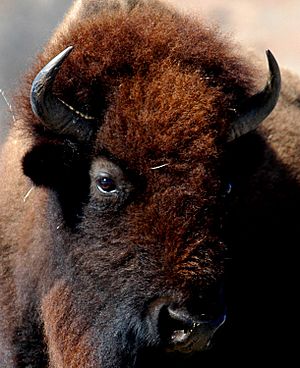
Even though they look similar, American and European bison have some differences. American bison have 15 ribs, while European bison have 14. American bison have four lumbar vertebrae (bones in the lower back), and European bison have five. Adult American bison also have shorter legs than European bison.
American bison tend to graze (eat grass) more than their European cousins. This is because their necks are shaped differently. American bison are also hairier, but their tails have less hair than European bison's tails.
The horns of European bison point forward, which helps them fight by locking horns. American bison prefer to charge when they fight. American bison are also easier to tame than European bison. They can also breed more easily with domestic cattle.
Where Do Bison Live Now?
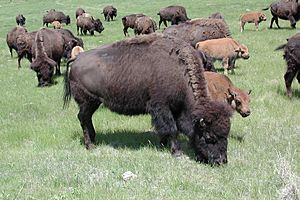
Bison live in herds owned by both the public and private ranchers. Custer State Park in South Dakota has about 1,500 bison. This is one of the largest public herds in the world. There are also about 500,000 bison on about 4,000 private ranches. These are mostly plains bison.
Today, bison are raised for their meat and hides (skins). Bison meat has less fat and cholesterol than beef. This led to the creation of beefalo, which is a mix of bison and domestic cattle.
Experts believe that truly wild and pure bison herds can only be found in a few places. These include Yellowstone National Park, Henry Mountains in Utah, Wind Cave National Park in South Dakota, and Elk Island National Park and Wood Buffalo National Park in Alberta, Canada.
It is thought that there are only about 12,000 to 15,000 pure bison left in the world. The rest have some genes from domestic cattle.
Bison Behavior
Bison are mostly grazers. Both male and female herds move with the seasons to find fresh annual grasses. Bison can eat most of the grass in an area quickly. So, they must keep moving to feed the whole herd.
Male and female herds stay separate until breeding season. Female bison live with other females and their young in groups called maternal herds. Male bison do not help raise the young. Male offspring leave these maternal herds when they are about three years old. They then live alone or join other males in groups called bachelor herds.
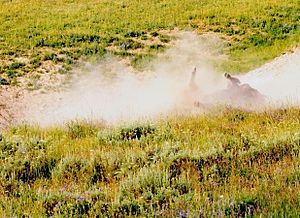
A bison wallow is a shallow dip in the ground. Bison roll in these spots, covering themselves with dust or mud. Scientists think bison wallow to clean themselves or just to play.
Who Hunts Bison?
In some areas, wolves are a main predator of bison. Wolves usually hunt bison in late spring and early summer. They often focus on herds with calves. Bison usually ignore wolves unless the wolves are acting like they are hunting.
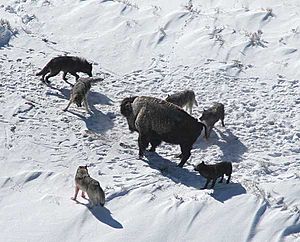
Bison have five ways to protect their calves from wolves. They might run to a cow, run to the herd, run to the nearest bull, run to the front or center of a stampeding herd, or go into water like lakes or rivers.
The Grizzly Bear can also be a danger to calves and sometimes even adult bison.
Hunting and Protection
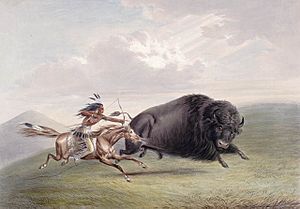
American Bison were hunted for hundreds of years by the Plains Indians. At first, they would chase bison on foot into corrals or over cliffs. After Europeans arrived, the Plains Indians could hunt bison using horses.
When Europeans moved west in the 1800s, the bison population was hunted very heavily. Americans hunted bison for their skins, often wasting the meat. This was sometimes done to take food away from the Plains Indians.
Native Americans also contributed to the decline of bison. The Comanche tribe alone killed 280,000 bison a year by the 1830s. However, unlike the Europeans, Native Americans used every part of the buffalo. A long and serious drought also harmed the bison population.
By the end of the 1800s, people who cared about nature noticed that there were very few bison left in the U.S. Even though the U.S. government did not help much at first, these conservationists started to protect the remaining bison. People like James "Scotty" Philip bought buffalo and raised them on private land. They hoped to bring the species back.
Canada, the United States, and Mexico consider bison both wild animals and farm animals. The rules for bison can be different in each state.
Bison Trails
Many of the first paths across America were made by bison. These routes, worn down by countless hooves, were used by Native Americans for hunting and as warrior paths. Explorers and pioneers also used them.
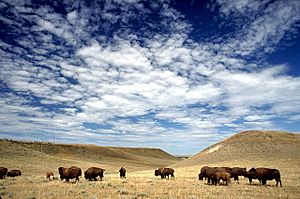
Many bison trails went north and south. But several important east-west trails were later used for railways. Some of these include the Cumberland Gap, which went from the Potomac River over the Allegheny mountains to the Ohio River. Another went through the Blue Ridge Mountains to upper Kentucky.
A heavily used trace crossed the Ohio River at the Falls of the Ohio. It then ran west, crossing the Wabash River near Vincennes, Indiana.
The bison helped create the paths for railroads to reach the Pacific.
Bison as a Symbol
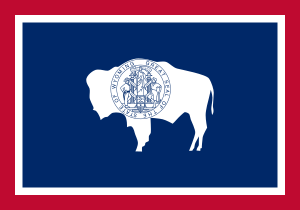
The American bison is often used in North America on official seals, flags, and logos. In the United States, the American Bison is a popular symbol in the Great Plains states. Kansas, Oklahoma, and Wyoming have chosen the bison as their official state mammal. Many sports teams also use the bison as their mascot.
In Canada, the bison is the official animal of the province of Manitoba. It appears on the Manitoba flag. It is also used in the official coat of arms of the Royal Canadian Mounted Police.
Several American coins feature the bison. The most famous is probably on the back of the "buffalo nickel" from 1913 to 1938. In 2005, the United States Mint made a new nickel with a bison design as part of its "Westward Journey" series.
The Kansas and North Dakota state quarters, part of the "50 State Quarter" series, each show a bison.
Dangers to Humans

Bison are among the most dangerous animals for visitors in U.S. and Canadian National Parks, especially Yellowstone National Park. Even though they don't eat meat, they will attack humans if they feel threatened.
They might look slow because of their calm movements, but they can easily outrun humans. They have been seen running as fast as 35 miles per hour (56 km/h).
Between 1978 and 1992, almost five times more people in Yellowstone National Park were hurt or killed by bison than by bears (56 by bison, 12 by bears). Bison are also more agile than you might think, given their large size.
Cool Facts About American Bison
- The scientific name for the bison is Bison bison.
- The word “bison” is both singular (one bison) and plural (many bison).
- A bison’s hump is made of strong muscle. It is supported by its vertebrae (backbones).
- Its hump helps the bison use its head like a snow plow to clear snow.
- A bison’s horns can grow up to two feet long.
- Bison eat plants and search for food for nine to eleven hours every day.
- A bison’s tail shows its mood. It might charge if its tail is standing straight up.
- Bison cannot see long distances very well. But they have excellent hearing and a great sense of smell.
- Bison are more agile than they look. They can jump six feet high, swim well, turn around quickly, and run up to 35 miles per hour.
- Bison ruminate their food, just like cows do. This means they chew their food again after swallowing it.
Images for kids
-
Adult male (back) and adult female (front), in Yellowstone National Park
-
Male plains bison in the Wichita Mountains of Oklahoma
-
Bison fighting in Grand Teton National Park in Moose, Wyoming
-
Bison herd grazing in Chihuahua, Mexico
-
A herd of American bison grazing at Tall Grass Prairie Preserve in Osage County, Oklahoma
-
A grizzly bear feeding on an American bison carcass.
-
Map from 1889 by William Temple Hornaday, showing where bison used to live.
-
A wood bison around Coal River in Canada
-
Bison being chased off a cliff as painted by Alfred Jacob Miller
-
Ulm Pishkun. Buffalo jump, SW of Great Falls, Montana. The Blackfoot drove bison over cliffs in the autumn to get food for winter. The Blackfoot used these "pishkuns" as late as the 1850s.
-
Series 1901 $10 bill showing explorers Meriwether Lewis, William Clark, and an American bison
See also
 In Spanish: Bisonte americano para niños
In Spanish: Bisonte americano para niños



